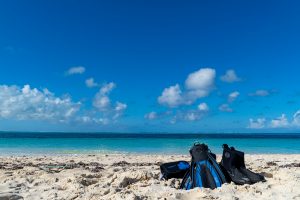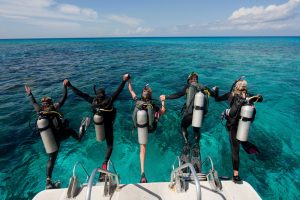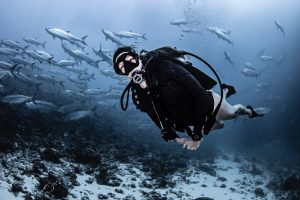

It’s common knowledge that wetsuits or even dry suits are essential for cold-water dives. But what many overlook is the need for thermal protection even in tropical destinations during summer.
The reason? Our core body temperature is much higher than the water we swim in, and water efficiently draws heat away from us, causing our core temperature to drop even in seemingly warm water. Additionally, water gets colder as we dive deeper.
Moreover, wetsuits provide UV protection and guard against jellyfish stings. There are numerous reasons to wear an exposure suit when scuba diving.
Even in warm water, along with essentials like a mask, regulator, BCD, tank, gauges, and dive computer, wetsuits and fins are crucial. Dive hood and gloves might be necessary, depending on your dive duration.
The thickness and fit of your neoprene gear matter. For warm conditions, 2-3 mm thickness suffices. Overly thick gear risks overheating, especially at the surface, while loose gear won’t effectively retain warmth.
In this piece, we’ll cover what to wear for warm-water scuba diving. You might be surprised by how cold warm water can feel after just 30 minutes, and the temperature difference between surface and underwater. Plus, sudden weather changes can impact water temperature, so it’s wise to wear insulating gear even in warm conditions
How warm is warm water?
Did you know that the term “warm water” is actually somewhat of a misnomer? It makes people drop their guard and think that they cannot be cold in it. They may foolishly think that they do not need to wear any sort of protection, and instead leave the majority of their body uncovered and unprotected. Warm water can actually feel cold, and it’s not just the cold you should be worried about.
The thought that even warm water can feel cold is hard to believe, especially considering how warm it feels at first and how blisteringly hot the surface temperature can be. So below, we’ve put some numbers to our claims to help you better understand what the temperatures are like inside your body and outside in the water around you.
- 98.6°F (37°C) – Normal body temperature measured with an oral thermometer.
- 99.6°F (37.5°C) – Deep body or core temperature measured with a rectal thermometer.
- 95°F (35°C) – For medical purposes, this is the clinical point at which hypothermia begins.
- 91°F (32.7°C) – The temperature of your skin.
- 85°F (29.4°C) – Water feels pleasantly cool rather than warm.
- 77-82°F (25-28°C) – Swimming pool temperature range for Olympic competition.
- 70°F (21°C) – Water feels quite cold to most people. Treat any water temperature cooler than this with caution.
As you can see, even at approximately 85°F (29.4°C), water feels pleasantly cool to our skin since it’s a few degrees cooler. This is about the temperature you can expect the water to be near the surface if you’re at a tropical destination in the summer. Of course, this is variable depending on the day, but it’ll likely be colder.
Swimming pools are often kept at around 77-82°F (25-28°C) which is even colder. All of these temperatures are lower than our core body temperature, and therefore prolonged exposure to them will cause our core temperature to drop. That’s why even “warm” water can cause your lips to turn blue and your body to shiver.
Since you plan on scuba diving, that means that you will: a) be in the water for around 45 minutes, and b) be exposed to water temperatures even cooler than the above since you’ll be deep underwater. If you attempt to do this without at least a wetsuit, you will almost certainly get hypothermia.
What equipment you’ll need
Dive mask
The dive mask is a highly versatile piece of equipment because not only can it be used for scuba diving, but it can also be used for snorkeling, freediving, and spearfishing. This piece of equipment helps us see beneath the water at the beautiful underwater world without saltwater hurting our eyes.
You specifically need a dive mask and not swimming goggles because a dive mask also covers the nose, which prevents water from entering it and also gives us the ability to equalize the water pressure at depth and stop mask squeeze.
Since a dive mask is our window to the underwater world, you had best make sure that it gives you a wide enough field of vision. Cheaper masks do not have side lenses or a see-through frame, and this means you are basically tunnel-visioned into looking in one direction and cannot rely on your peripheral vision. You can even get a mask with prescription lenses.
We also recommend you take your time getting a dive mask that fits comfortably. After all, a leaking mask is a useless mask, and one that’s too tight will feel uncomfortable, so your whole dive experience can be ruined just from an ill-fitting mask. We’ve already written numerous reviews on the best dive masks, as well as guides on how to find the right fit, so we won’t get into that again.
Fins
Another crucial part of a complete scuba diving kit are the fins. Human feet just aren’t energy-efficient for propelling ourselves, and you’ll find yourself gasping for breath. Fins help you propel yourself through the water. They will make it more tiring to kick your legs, but trust us, the extra effort is worth it for how much thrust you gain.
Be very careful to purchase fins for scuba diving and not fins for snorkeling or freediving. We recommend you read this article to learn about the distinctions, but basically the main differences are found in their: fin length, thrust efficiency, heel type, and blade stiffness.
There are also various other considerations: split fins or paddle fins? Full foot or open heel? A full foot fin kind of feels like wearing a shoe. With an open heel design, you can wear booties with the fin for extra insulation. This can also reduce any uncomfortable rubbing that the fin might cause to your feet.
For snorkeling, fins are not strictly necessary, but for scuba diving they are essential because you’re carrying a lot more gear with you.
As you can see, there are a lot of factors to consider, so do your research. As always, fit is very important, so try them on if you can. If you are wearing booties, then the heel size must account for the extra thickness of the booties in addition to your feet size.
Gloves and diving hood (optional)
Gloves and diving hood are not strictly necessary for warm water diving, however they are nice to have in case the temperature gets colder. Our extremities and the top of our head are an often overlooked source of heat loss. Plus, covering them up offers extra protection, so it’s generally a good idea.
With dive gloves, you have to consider how much they affect your dexterity and precision. If you plan on operating a camera or doing precise button-pressing with your fingers, then gloves will make things more awkward. You may decide to forgo them if you feel that the insulation they provide is unnecessary.
And as for a diving hood, they are useful for keeping your head warm, but they also have some niche uses. For instance, a diving hood can also keep your hair out of the way, as well as cover up your facial hair so that you won’t run into any issues with hair obstructing your view or getting caught on the mask skirt.
Exposure suit
The piece of equipment with the most contention regarding their usefulness for warm water diving is the wetsuit. Depending on how warm it is, some people will say that you only need a rash guard, a swim shirt, or maybe you don’t even need to wear anything at all.
We believe that no matter if you’re in cold water or warm water, you need some kind of exposure suit. As we’ve already mentioned, covering yourself up can at least protect you from superficial injuries, such as cuts, stings, and even the sun’s harmful UV rays. It will save you a lot of time and effort since you won’t need to apply sunscreen as much.
Wetsuits come in many varieties. You can get full wetsuits, shorty wetsuits, two-piece wetsuits, and wetsuits come in various thicknesses. Make sure that you are specifically buying a wetsuit for scuba diving and not one for surfing or swimming or any other water sport.
Continuing on from the temperatures provided in the “How warm is warm water” section, you can determine what wetsuit thickness you may need for the water temperature you’ll be exposed to.
| Water Temperature Range | Wetsuit Thickness | Recommended Wetsuit Type | Seal Type |
| >72°F (>22°C) | N/A | Rash guard | N/A |
| 65°- 75°F (18° – 24°C) | 0.5 mm – 2/1 mm | Top / Shorty | N/A |
| 62°- 68°F (16° – 20°C) | 2 mm – 3/2 mm | Springsuit / Full Suit | Flatlock |
| 58°- 63°F (14° – 17°C) | 3/2 mm – 4/3 mm | Full Suit + Boots | Sealed |
| 52°- 58°F (11° – 14°C) | 4/3 mm – 5/4/3 mm | Full Suit + Boots + Gloves + Hood | Sealed and Taped |
| 43°- 52°F (6° – 11°C) | 5/4 mm – 5/4/3 mm | Full Suit + Boots + Gloves + Hood | Sealed and Taped |
| 42°F (6°C) and below | 6/5 mm + | Full Suit + Boots + Gloves + Hood | Sealed and Taped |
So that you don’t get a heatstroke at the surface, you can get a thin wetsuit top or a shorty wetsuit so that you can get some relief from the heat. If your goal is to stay insulated, we do not recommend getting a rashie because they are not designed to keep you warm unlike a wetsuit.
As the water temperatures get colder, in addition to getting a thicker wetsuit, you can also consider wearing a diving hood, gloves, and booties if you are more sensitive to the cold. A higher quality wetsuit would also have their seams blindstitched, taped, and glued to ensure no water will leak through there.
Be careful if you’re buying a used wetsuit because it may be worn down such that it’s not as insulating as it used to be. They may also have received questionable care, so this might be one that you want to buy new.
Conversely, new wetsuits might feel extremely stiff and you might consider it to be a poor fit. Give yourself some time to break it in before you even wear it out to the water. As soon as a wetsuit touches water, you won’t be able to return it anymore.
Scuba cylinder
Well, this piece of equipment is unavoidable. How can you stay underwater for long without breathing air? The scuba cylinder is what transports your breathing gas, whether that’s standard air, nitrox, or trimix, so that you can stay underwater for far longer than the natural breath-hold limit.
People who only casually scuba dive don’t need to buy their own scuba tank. Instead, the vast majority of people prefer to rent their tanks so that they don’t have to deal with the hassles of transportation or long term storage. Additionally, scuba tanks need to be inspected at least once a year (called a visual inspection), and every 5th year a hydrostatic pressure test must be conducted. This test can potentially destroy your tank, and you have to pay for the inspections as well.
When you’re renting, you will only be limited to aluminum scuba tanks. They are generally heavier than steel tanks, however they are also more buoyant underwater. Plus, if you rented it, then you don’t have to deal with lugging it around except to and from the dive shop.
Regulator and gauges
Just as iconic as the scuba tank is, the scuba regulator is a major part of the scuba diver “image” and for good reason. The regulator is what converts the highly pressurized gas inside the scuba cylinder into something that’s safe to breathe for humans.
You need to have a primary regulator and an alternate/backup regulator, also known as the “octopus”. Having two regulators is absolutely crucial for not just your safety, but your dive buddy’s as well. Should your main regulator fail or your buddy runs out of air, the alternate air source is your insurance.
Regulators also come in cold water varieties, but since the focus of this article is on warm water diving, you’ll likely not need it. However, cold water regulators are highly versatile because you can use them for freshwater diving as well.
Next, your gauges are another vital part of the dive kit. You must at least have a submersible pressure gauge (SPG) to track remaining breathing gas in the tank, and it might also come with a depth gauge and a compass. These gauges provide vital information that the dive computer also provides. However, it’s good to have redundancy, and it’s also good to have a point of reference in case there is a large discrepancy between the gauge readings and your dive computer display.
Buoyancy Compensator/Buoyancy Control Device
Scuba divers control how they go up and down using their buoyancy compensator or buoyancy control device (BCD). At the surface, they are fully inflated so that divers do not plummet to the bottom of the ocean with all of the extra weight the gear adds. Whether you are warm water diving or cold water diving, the BCD is another one of those essential scuba gear you need.
They are essentially jackets or vests that have inflatable/deflatable air bladders. The BCD also connects to your scuba tank so that it can inflate your BCD as needed. Good control is needed so that you can steadily reach the maximum depth and maintain neutral buoyancy at that depth, which is when you are floating in place. Inexperienced divers may waste a lot of air inflating their BCD, so it’s important to have mastery over the BCD.
Additionally, BCDs have pockets and straps to store or attach your dive accessories . However, keep in mind that the more accessories you have, the more weight and bulk you’re adding to your scuba kit.
Snorkel, cameras, accessories
There are many other gear you can bring with you when warm water diving. Accessories can greatly enhance your diving experience, but some of them may not be needed. A very common accessory is an underwater camera so that you can capture and immortalize your exciting adventures underwater.
Underwater photography is basically photography on steroids. There’s already so much to learn about scuba diving, and you could already spend thousands getting shiny new dive gear. Underwater photography is an extra layer of complexity on top of that (and arguably an even bigger money sink). We won’t get too much into underwater cameras or underwater photography because first you need to get to the bottom of the rabbit hole known as scuba diving before you jump into another rabbit hole.
Moving on, you might also want to bring with you a dive torch and a dive knife . The deeper you dive, the darker it gets, so an underwater flashlight can let you see clearly at any depth. The dive knife is important to have in case you ever get tangled up in a net or rope; you can easily free yourself and prevent an accident. Be sure to wear it in an easily accessible location so you can grab it in an emergency.
One scuba accessory that we consider to be essential is a delayed surface marker buoy, or DSMB for short. The DSMB can alert people at the surface about your location before you surface. This is crucial because otherwise a boat collision might otherwise occur and this is fatal. It can also be used to help others locate you in an emergency. You can learn more about DSMBs in PADI’s DSMB course.
Parting words







